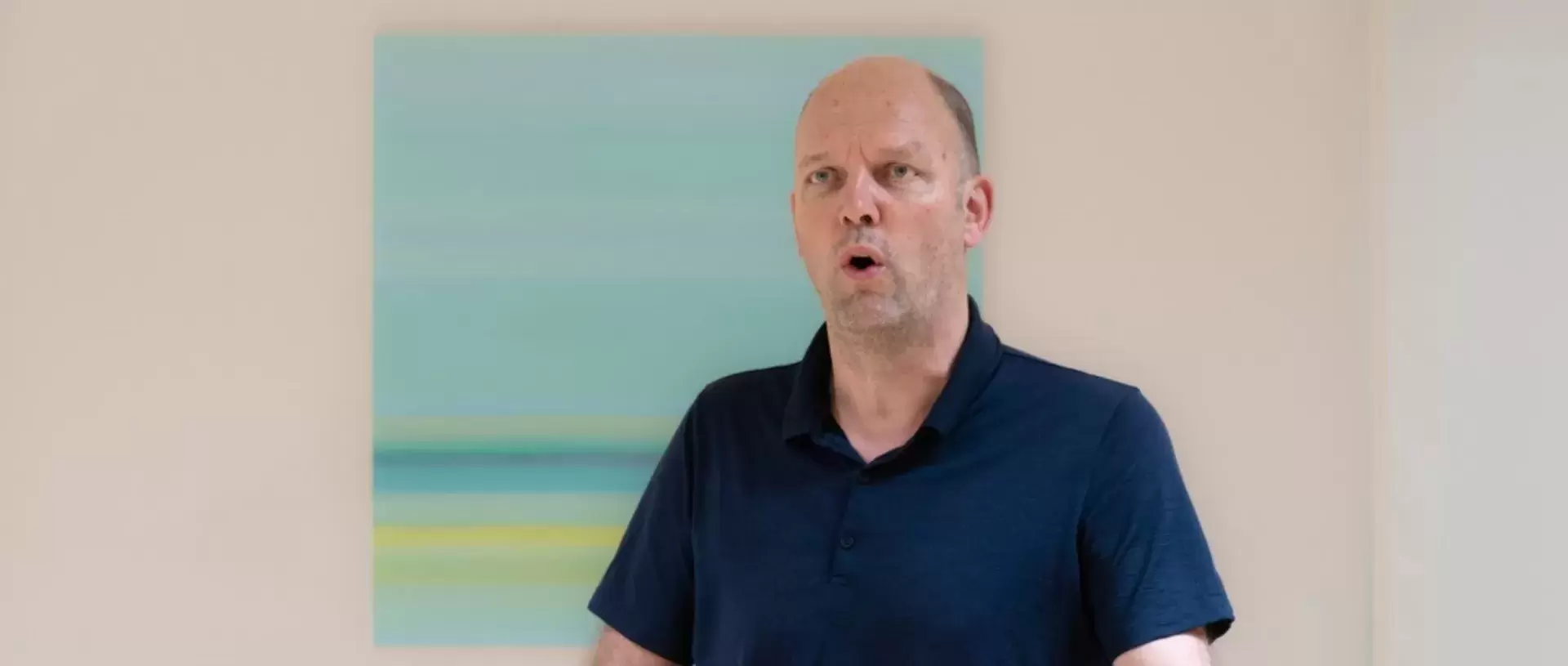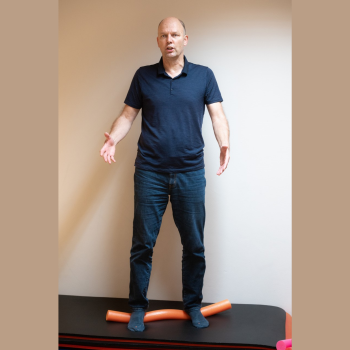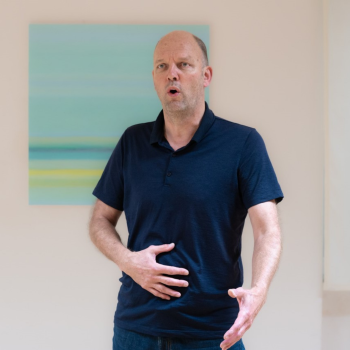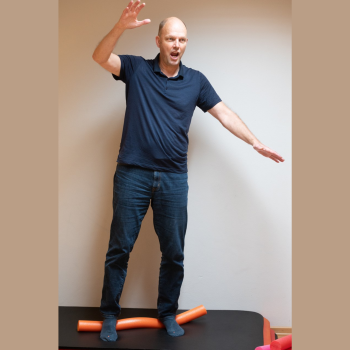For many years, it has always been a special pleasure for me to work with musicians. As a member of a vocal ensemble, my professional interest in the specific challenges of the musical profession is combined with my personal joy in making music. Together with my wife, Bettina Löns (PT and dancer) we have conducted many workshops for professional singers.
The amazing thing for me is how many ‘parallels’ music and Rolfing®have.
An example is perhaps the connection between sound and ‘inner space’ for singers: Too much tension (fascial and/or muscular) in the neck area narrows this ‘resonance space’ and influences the sound. As Rolfers®, we strive to regulate tensions and expand spaces. Peter Melchior described the connection between SI and artistic work during my training as follows: ‘We Rolfers® are artisans on the living body’.
Often, actually always, the musicians can hear the ‘sound of Rolfing®’. In my opinion, the structural and functional changes can help to improve musical expression.
Even if these differences were not only noticeable in singers, I would like to limit my experiences with this group of musicians as an example.
Working with singers
For singers, the question always arises as to how the body is used as an instrument. The actual resonance space to produce sound seems to be relatively limited. Essentially, therefore, head, visceral part of the neck and cervical region, as well as the upper chest cavity. As a Rolfer, one could therefore assume that in this case topics from the 7th session are in the foreground.
Over the years, however, it has become clear that it is particularly important to consider the structural and functional relationships of the entire organism in such a specific work. For this purpose, the Ten Series by Dr. Ida Rolf proves to be particularly helpful as an orientation and the learning of structural and functional relationships for the singers.
Nevertheless, I would like to point out some interesting anatomical relationships that deserve special attention -
- The visceral neck:
The resonance space of a singer depends on the ability to adjust the larynx as low as possible. This refers to both the physical and coordinative structure. This means, for example, for the structure in the hyoid muscles, that on the one hand the myofascial elasticity as well as the coordinative abilities are decisive for a favourable adjustment of the larynx.
Tensions in all fascia layers of the neck (lamina superficialis, but especially lamina pre-tracheal and the prevertebral cervical fascia) can contribute to the reduction of the resonance space.
On the functional-coordinative level, an active M. longus colli for a reduction of phasic activity and thus also for the enlargement of the sound space when singing.
The reduced activity of SCM and M. scaleni play an important role in the preparation of a tone. The less these muscles are used in the inhaled movement, the more resonance or overtones can arise.
- The posterior neck area (neural neck):
Tensions in the long-levered rear phasic musculature naturally play a major role in the organisation of the head and cervical area. An imbalance in the tension between the front and back influences flexibility and thus space. In the case of increased cervical lordosis, the anterior neck area appears "open", at the same time the tension in this area is often high in response to the cervical position. If, on the other hand, the cervy is "steep", this is even more at the expense of a front sound space.
- TMG and tongue:
How the resonance space can be used is determined not least by the structural conditions around the temporomandibular joint and the tongue space. The flexibility of the mouth opening is of great importance as preparation for inhalation but also for text articulation. Structures such as the M. temporalis, M. masseter and Buccinator as well as in the oral cavity Pterygoid are the associated myofascial structures.
- The shoulder girdle:
Of course, I would also like to mention the manifold influences of the shoulder girdle on the rooms available to produce sound when singing. Traps, Levator scapulae in the posterior area and Pecs, Subclavius in the anterior region are relatively superficial structures that can play a role here. But also tensions and coordinative deficits of the rotator cuff in connection with the Omohyoids can have a detrimental effect on the resonance space. This is especially true for the initiation of single movements: one could also say that increased activity or tension narrows the spaces.
The example is actually a transition to the functional relationships, which I would like to briefly discuss.
In summary, it can be said that increased stress changes in the described myofascial structures reduce the available resonance space. This influences the timbre and sonority produced mainly by the generation of overtones. Ultimately, the possibilities of musical expression are limited.
Here it becomes clear that at the level of coordination of the local physical structures involved, of course, the entire body is involved. The overarching question of what prevents the voice from unfolding its inherent possibilities comes to the fore.
We can consider the resulting coordinative structures from different perspectives:
- Orientation
This is mainly about the combination of spatial and floor orientation. This connection is one of the prerequisites for a supporting activity from other areas.
- Core stability and tonic function
The model of the so-called postural triangle – sensors of the feet, eyes and vestibulum – summarises the relationship between alignment along the gravity line and tonic activity. Stability is ensured by internal structures (core), phasic activities are prevented, whereby resonance spaces can be used and changed flexibly and adaptively.
- From the point of view of the underlying Rolfing-principles, it becomes clear that a musical-playful handling of voice without support neither adaptability nor a desirable resilience / palintonicity is only possible to a limited extent. From a musical point of view, this means a limitation of expression – the result is audible!
For the singers, of course, this plays a particularly important role. What does ‘my’ interpretation sound like, for example? The perceptive structure – to use the terms used in Rolfing – is involved in different ways.
- The hearing naturally plays an overriding role as a reference for the sound. For example, how do different variants of a phrase, a song, etc. sound? During a vocal development, the ability to hear – e.g. during intonation – is trained in a natural way.
- The ability to perceive states of tension in different areas of the body creates connections and creates awareness of the interaction of different structures and functions and their influence on the sound of the voice.
- This leads to the development of ‘indicators’ to determine both the ‘actual state’ in terms of voice and its connection to the whole body and the interaction of internal and external spaces (body and environment).
In conclusion, one can perhaps say that the feeling for one's own musical expression improves as a result. It complements vocal abilities and can possibly lead to more pleasure in personal exploration of new possibilities and replace old less useful concepts about the design of one's own singing (body image).
As a Rolfer I use the term psychobiological structure (meaninge) – or in other words – everything makes sense!
Practical implementation for Rolfing work with musicians
Anamnesis:
For working with musicians, it is particularly important to formulate a goal together that seems realistic in the context of a series of Ten Series.
This also means that the musicians develop an extended repertoire of possibilities to check the effects. In concrete terms, this often means that physical relationships such as the interaction of voice and myofascial tensions can be experienced individually.
Procedure:
Within this framework, repetitive - in a broader sense standardised - procedures are therefore important to check progress. This means that new possibilities can be better integrated.
An example: The preparation of a vocal phrase is closely related to the execution of the inhaled movement. Activities in the shoulder girdle and/or jaw area are not very helpful. This would be visible in body reading. The so-called pre-movement would be the indicator of this activity here. Reasons can be a lack of ‘support’ from the lower limb, less coordinated and flexible connection from ‘above and below’ through the pelvis, etc. The voice and its different sound variants can be indicators for the singers to feel these individual connections. At this point, it becomes clear that during a series of treatments, repeated functional work in gravity is of great importance. Singing or playing the instrument within a treatment is often very helpful for the implementation and integration of structural changes.
Author: Certified Advanced Rolfer®, Rolf Movement™ Practitioner and Dr Ida Rolf Institute® Europe Faculty Member, Jörg Ahrend-Löns - Germany










